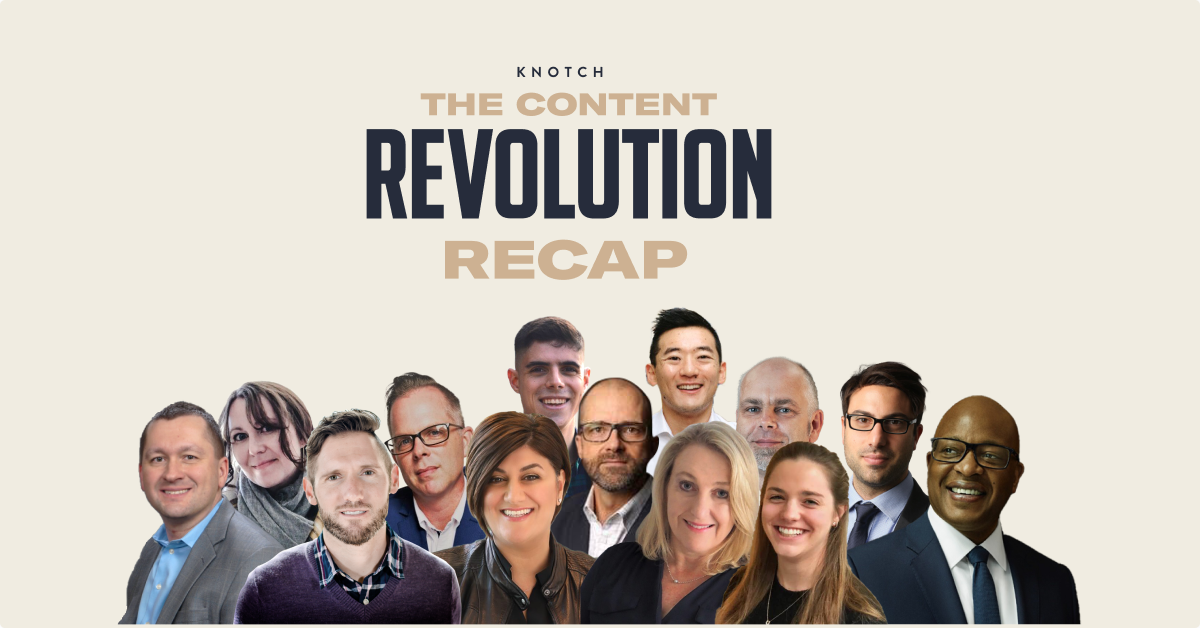The Content Revolution event was created in an effort to say out loud what’s been staring us in the face for most of 2020: There’s been a fundamental change around what content is, who it’s for, how it’s produced, and the strategic role it plays in driving business outcomes.
“COVID-19 and George Floyd’s murder have challenged content leaders to create meaningful, nuanced content in real-time,” Knotch CEO Anda Gansca said during her opening remarks. “This has led to a rise in the need for content creators and greater buy-in for the power of content as a practice across the business landscape.”
In our research leading up to the event, we found that over 62% of marketers who implemented content into their marketing mix during the pandemic have seen an increase in brand awareness and customer retention (CMO Survey). Another 35% said they struggle to produce enough content to engage their audience (The Drum), and 31% said their content team size has increased in the past year despite the pandemic (Content Marketing Institute).
With this knowledge in hand, we set out to gather up some of the brightest content minds working today to ask them questions about the revolutionary new ways brands are creating, using, and thinking about content.
Here’s what they told us.
Brand & Reputation Rely On Content

In our opening session, “Thriving in an Evolving Content Landscape,” BlackRock CMO Frank Cooper talked about the rapid changes we are experiencing as a society in light of the global pandemic and reckoning on racial injustice.
He believes these changes have brought businesses closer to societal issues than ever before, and that content—which he has evangelized since joining BlackRock—is the way for brands to reach consumers and cultivate the brand’s reputation.
“Trust in your organization comes from direct interactions you have with people,” Cooper said. “Therefore, your content should serve to inform, inspire, and increase the ability of people to act.”
At BlackRock, this has manifested in a greater investment in content that improves financial literacy and allows consumers to make smarter decisions with their money.
“With finance content, there should be no jargon or footnotes,” Cooper said. “Great financial content should be short-form, visual, intuitive, and relatable. And that’s what we’re doing here.”
Emotion Should Be Used to Measure Content

In our second session of the day, “Rising Trends in Content Technology,” our panelists discussed how their organizations are adjusting their approach to content, and what metrics they’re using to measure content success.
“Emotion is becoming a way to measure content,” said Brad Armstrong, CMO at National Instruments. “With every piece of content we create, we want to understand the user’s emotional state going in, and going out.”
“We try to think if our content is changing hearts and minds, not just legacy engagement metrics,” added fellow panelist Aaron Bernstein, Senior Director 2 of Insights & Advocacy at Walmart.
Lauren Busch, who heads up global marketing at BlackRock, said her team also seeks to understand how users feel when they consume their content.
“Are we building trust with our target audience? Are we improving our reputation? These are questions we ask ourselves when we’re reviewing a piece of content,” Busch said.
Content Is An Organization-Wide Commitment

In our “Content Champions Roundtable” discussion, all of our panelists said successful content operations require participation from everyone within the organization.
“The whole organization needs to have a digital mindset, because that’s what grows the brand,” said Yves Le Breton, Global Head of Ecommerce at Inside Ideas Group.
But fostering a content-first culture requires buy-in from every level of the organization. That’s why fellow panelist Amanda Wolff, CMO at OneSpace, said every content team needs data.
“Data is how you support your case to leadership,” Wolff said.
Le Breton echoed her sentiment.
“The best, and only way if you ask me, to convince someone is through data.”
Good Content Takes Curiosity

During our “Opportunity Makers” session, Carla Hassan, CMO at Citi, talked about what it will take to sustain the content revolution.
In a word? Curiosity.
“We are all in these companies to do one thing: grow the business,” Hassan told Gansca. “Every marketer needs to have an inherent curiosity about the business you are in and what your objectives are.”
This curiosity to solve business problems will help marketers create content that more closely relates to the core objectives of the business. Hassan added that it will also take cooperation and planning to bring about a content revolution within your organization in a meaningful way.
“Revolutions have an incredible creative energy, but they are also chaotic,” says Hassan. “We know that everyone is creating more content now. The best thing we can do is brainstorm how we can bring order to all of that content creation.”
The Long Term Outlook for Content Professionals Is Bright

In our final session of the day, I (Matthew Speiser) talked about our 2020 State of Content Careers Report, and teased a few fun insights, including:
- There are over 9 million people working in content-related roles today.
- There’s been a 35% increase in content jobs in 2020 compared to 2018.
- 40% of new content job postings ask for professionals with manager-level experience.
- 58% of the new jobs in content are based in the technology sector.
- Social media and SEO are the most in-demand skills sought after in content pros.
There are many more insights available in our 2020 State of Content Careers report, which you can download using the following link:
USE THIS LINK TO DOWNLOAD THE 2020 STATE OF CONTENT CAREERS
The Revolution Lives On
This is just a sampling of the conversations our panelists had at The Content Revolution. Recordings from the event will be posted to the Knotch site next week.















